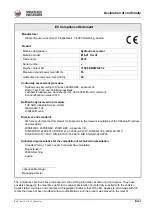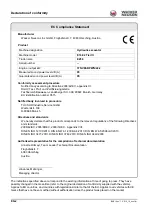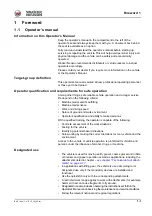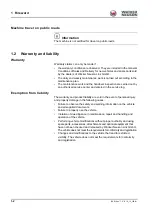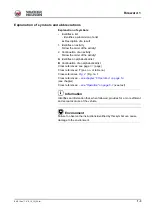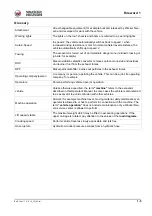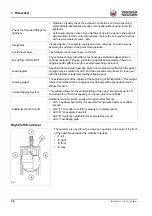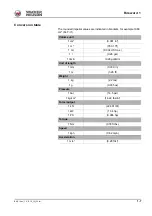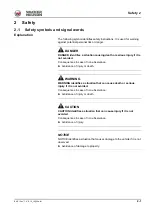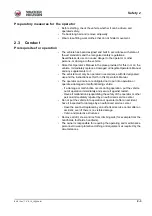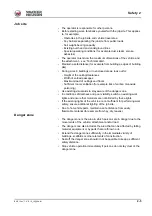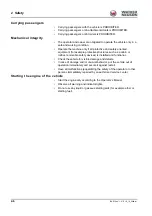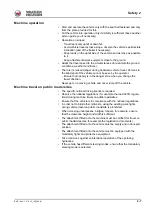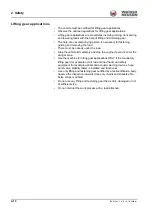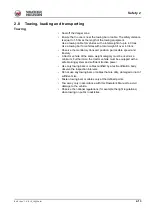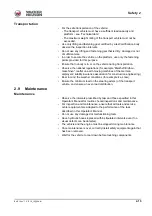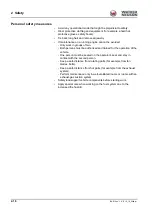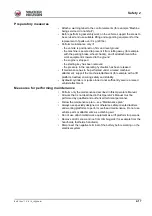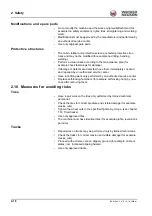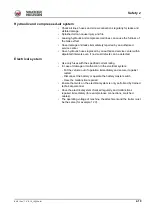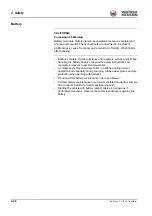
BA E16 en* 1.0 * E16_10_200a.fm
2-5
Safety 2
Job site
• The operator is responsible for other persons.
• Before starting work, familiarize yourself with the job site. This applies
to, for example:
- Obstacles in the job site and vehicle travel area
- Any barriers separating the job site from public roads
- Soil weight-bearing capacity
- Existing overhead and underground lines
- Special operating conditions (for example dust, steam, smoke,
asbestos)
• The operator must know the maximum dimensions of the vehicle and
the attachment – see “Technical data”.
• Maintain a safe distance (for example from buildings, edges of building
pits).
• During work in buildings or in enclosed areas, look out for:
- Height of the ceiling/clearances
- Width of entries/passages
- Maximum load of ceilings and floors
- Sufficient room ventilation (for example risk of carbon monoxide
poisoning)
• Use existing visual aids to stay aware of the danger zone.
• In conditions of darkness and poor visibility, switch on existing work
lights and ensure that motorists are not blinded by these lights.
• If the existing lights of the vehicle are not sufficient for performing work
safely, ensure additional lighting of the job site.
• Due to hot vehicle parts, maintain a safe distance from easily
flammable material (for example from hay, dry leaves).
Danger zone
• The danger zone is the area in which persons are in danger due to the
movements of the vehicle, attachment and/or load.
• The danger zone also includes the area that can be affected by falling
material, equipment or by parts that are thrown out.
• Extend the danger zone sufficiently in the immediate vicinity of
buildings, scaffolds or other elements of construction.
• Seal off the danger zone should it not be possible to keep a sufficient
safety distance.
• Stop vehicle operation immediately if persons do not stay clear of the
danger zone.
Summary of Contents for ET35
Page 14: ...1 8 BA E16 en 1 0 E16_10_100 fm 1 Foreword Notes...
Page 46: ...3 8 BA E16 en 1 0 E16_10_300 fm 3 Introduction Warning labels Fig 9 symbolic representation...
Page 64: ...3 26 BA E16 en 1 0 E16_10_300 fm 3 Introduction Notes...
Page 194: ...6 8 BA E16 en 1 0 E16_10_600 fm 6 Transportation Notes...
Page 252: ...8 8 BA E16 en 1 0 E16_10_800 fm 8 Malfunctions Notes...
Page 292: ...9 40 BA E16 en 1 0 E16_10_900 fm 9 Technical data 9 15 Dimensions ET35 symbolic representation...
Page 294: ...9 42 BA E16 en 1 0 E16_10_900 fm 9 Technical data EZ36 symbolic representation...
Page 296: ...9 44 BA E16 en 1 0 E16_10_900 fm 9 Technical data Notes...
Page 300: ...S 4 BA E16 en 1 0 E16_10_3SIX fm...

